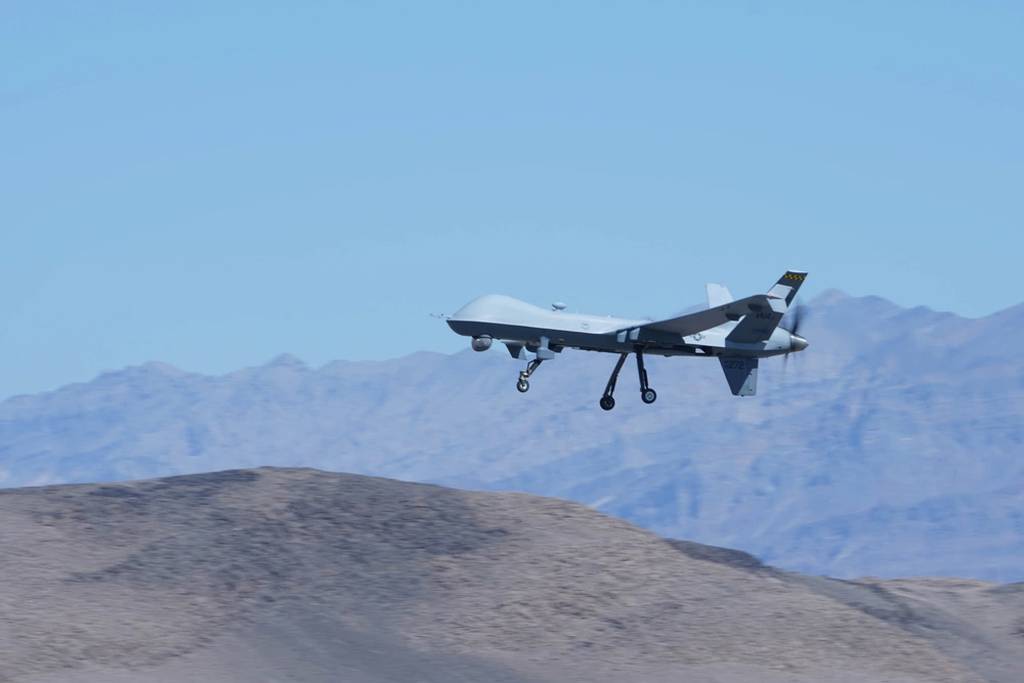A Russian surface-to-air missile nearly hit an American MQ-9 Reaper drone over Syria in a previously undisclosed incident last November, U.S. Central Command confirmed Thursday.
The near-shootdown is the second known skirmish between Russian forces and U.S. drones in recent months, amid growing tensions between the two countries in conflict zones where both maintain a military presence. Air and Space Forces Magazine first reported the incident on Wednesday.
“We can confirm that a Russian-controlled SA-22 fired a missile at a U.S. MQ-9 on November 27, 2022,” CENTCOM spokesperson Maj. John Moore said in an emailed statement.
While Air and Space Forces Magazine reported the attack drone was damaged, Moore said the military was not aware of the missile exploding or the MQ-9 being hit.
CENTCOM spokesperson Will Laney declined to answer whether the command believes the missile was intentionally or accidentally fired.
The interaction prompted U.S. officials to contact Russian troops on a deconfliction hotline the two powers maintain to avoid confusion and potential altercations between their air forces.
“This kind of behavior is not what we expect from a professional force,” Moore said.
Four months later, on March 14, a Russian Su-27 harassed an MQ-9 Reaper intelligence drone on patrol over the Black Sea, apparently damaging it enough that the U.S. opted to bring it down into the water.
It was the first time such an interaction was made public since the beginning of Russia’s large-scale invasion of Ukraine in February 2022. U.S. officials pointed to the incident as a uniquely unsafe moment in an area where Russian and American aircraft routinely pass without a problem.
The November incident comes to light as Russian forces grow increasingly confrontational in Syria, where Moscow backs the Assad regime and Washington supports the patchwork of rebel groups in the country’s 12-year civil war. The U.S. and Russia are also waging parallel campaigns against Islamic State militants who have gained a foothold amid the power vacuum there. About 900 U.S. personnel remain in Syria.
Russian aircraft violated agreed-upon deconfliction protocols 85 times from March 1 to April 28, including 26 times when armed aircraft flew over U.S. positions, Lt. Col. Marnee Losurdo, a spokesperson for CENTCOM’s Air Force branch, said May 1.
That’s about six times the violations Russia logged in January and February, combined, according to Air Forces Central.
The countries have established areas where, if aircraft are traveling through, they are supposed to notify each other, and they have agreed to stay at least 3 nautical miles apart from other aircraft and 3,000 feet above ground forces while in transit. The U.S.-led coalition’s al-Tanf garrison, on the border with Jordan and Iraq, is protected by a 34-mile deconfliction zone. Armed overflights are banned under the protocols as well.
Yet Russian pilots have flown in a “loose formation” within 500 feet of American jets multiple times this spring, appearing to urge U.S. pilots to dogfight, Air Forces Central Commander Lt. Gen. Alexus Grynkewich recently told news outlets.
The Air Force in April released two videos that appear to show Russian Su-35 fighter jets veering close to American F-16 fighters in coalition airspace over Syria, filmed from the viewpoint of the F-16.
Grynkewich questioned why Russian forces are opening themselves up to the possibility of escalation by flying over U.S. troops with air-to-ground munitions.
“I don’t think that anyone’s going to give an order for Russians to go in [and] attack a position or anything like that,” he told the Wall Street Journal April 24. “But I do think it increases the risk of miscalculation.”
Grynkewich has suggested Russians may be growing more brash as a favor to their ally Iran, which opposes the U.S. military presence in the region. In response, the Air Force has dispatched A-10C “Warthog” attack planes that are specially modified to carry around three times their typical bomb load.
“They’re really here as a message to both assure our partners … but also as … a true capability that can work against some of the threats that we face with respect to Iran,” Grynkewich told Defense One.
Each plane can carry up to 16 Small Diameter Bombs, plus laser-guided rockets and its 30mm Gatling gun.
“That’s a lot of targets that you can hit from an air-to-ground perspective,” Grynkewich said.
Rachel Cohen is the editor of Air Force Times. She joined the publication as its senior reporter in March 2021. Her work has appeared in the Washington Post, the Frederick News-Post (Md.), Air and Space Forces Magazine, Inside Defense, Inside Health Policy and elsewhere.








